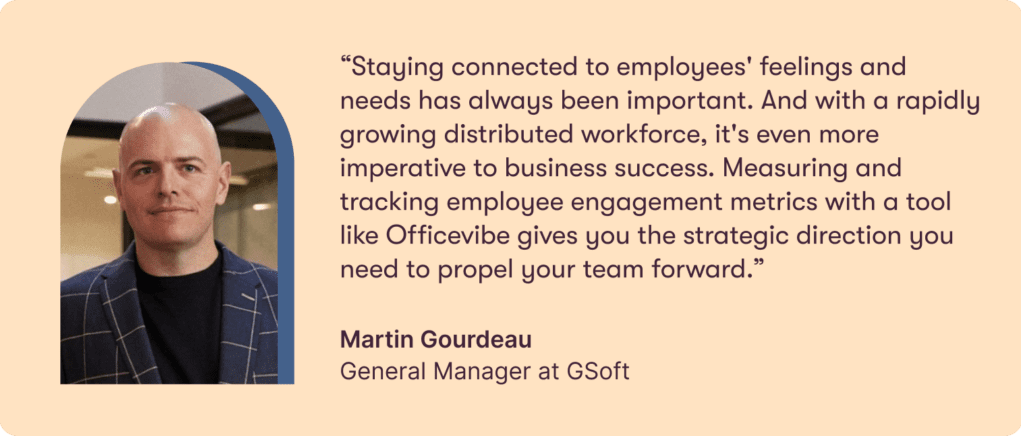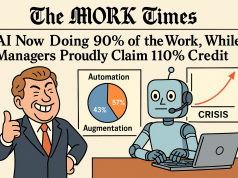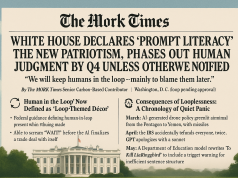[ad_1]
Published on: February 3, 2023 |
Reading time: 11m
Officevibe is loved by managers and HR teams worldwide. But more and more, C-Level executives are taking notice (and advantage) of the tool. We sat down with Martin Gourdeau, President and General Manager at GSoft, who shares how Officevibe has become an integral part of his daily reality — informing decisions at all levels, delivering true business value, and benefiting the company’s bottom line.

Here’s what we spoke about:
The golden rule for great leaders
[Officevibe] We’re stoked to chat with you today, thanks for taking the time! Officevibe has been successfully adopted by thousands of managers and employees worldwide, and we’re excited to have an inside look into the business value it has highlighted for GSoft from your executive perspective.
Before we jump into things, we want to better understand you as a leader and businessperson. So, what’s your golden rule when it comes to leadership?
[Martin] Well, right off the bat, everything I’m going to say is linked to one of my core beliefs, which is that people are the most important part of any business. I’ve never heard any rational argument stand up against that notion, ever, so I have to put that out there before we get started because it plays into everything that’s great about Officevibe.
Having a good read on your people and how they feel is key if you’re looking to have any real, honest visibility on your business’s health. I’ve always believed that, but this is especially true in distributed environments, where visibility becomes five, probably ten times more important. And that’s why Officevibe is now part of my everyday workflow.
How to use Officevibe for optimal visibility on employee insights
Considering so many businesses, including GSoft, now operate with hybrid or distributed teams, that’s more relevant than ever. So can you walk us through your relationship with Officevibe and how you use it to gain better visibility on the business and its people?
In general, and I think most executives will relate here, my morning routine starts by looking at a bunch of data — business metrics, like products and value delivered, roadmaps, and so on. One of the first things I do is open Officevibe to get a sense of the state of affairs of our teams.
I look at engagement trends — especially the eNPS (employee Net Promoter Score). I also take a quick look at employee feedback as it gives me information on how the business can be improved at different levels and from different perspectives.
Another feature I look at almost every day is the comparison report. I mainly look for discrepancies — that’s usually when I’ll look into an issue further or flag it at the right level.

There’s also the goals feature which, in my opinion, is one of the most valuable and underused features of Officevibe. I use the “tree view”, so I can drill down to understand every single OKR and how they connect back to top-level objectives. In my professional experience, I haven’t found any other tool that helps with strategic planning as well. For me, those features help me make correlations between how things are going in terms of delivery, sales, retention, and churn, across all other product, business, or finance metrics.

“Engagement metrics can be considered predictive indicators for business metrics. They point towards a confidence level of how things are going now and how they’re going to be going over the next few months.”
What’s super interesting is that engagement metrics can also be considered predictive indicators for business metrics. They point towards a confidence level of how things are going now and how they’re going to be going over the next few months.
For example, let’s say an event occurs that causes engagement metrics to start dropping. You could expect that to have an impact on business metrics, although there’s usually a delayed effect. If engagement starts going down, it’s almost inevitable that business metrics will follow at some level — this could mean sales, retention, or product metrics.
Like I said, people are the most important part of a business, so being able to visualize the state of a company from the perspective of its employees is incredibly helpful to run your operations. Sort of like a strategic looking-glass from the inside-out… with a bit of foretelling.
There are many engagement metrics executives can consider, and each one plays a role within the big picture of an organization. Officevibe also offers a sub-metrics view, which contributes to the employee experience. Discover our top 10 engagement metrics.
We love the predictive aspect and how you use Officevibe day-to-day. Was it a natural adoption process for you when you first got access to the tool?
Ha! As one of our products, you’d expect I was using it since day one! But the truth is, I wasn’t spending much time using it in the beginning. Don’t get me wrong — I had heard a lot about Officevibe. But I had no idea of the powerful business insights that could come from it.
It was once I had a sit-down with Simon [De Baene, Co-Founder & CEO], where we talked about the tool, that things really clicked for me. Simon shared how he was using Officevibe and that got me curious. Once I started playing around with it and experiencing its value myself, I was hooked.
For someone in my position, a tool that can give you business insights that help with your decision-making process is incredibly valuable. So, I’ll admit — I didn’t give Officevibe much love the first few weeks. But once I saw I could chase real business value through the tool, it naturally became a part of my reality.
Improving daily operations with an employee experience platform
As a leader, in what other ways has Officevibe helped improve your daily operations? How would you say it helps the specific realities of an executive?
Officevibe gives you a good understanding of a team or an employee’s capacity, and that can provide very useful knowledge. If I need to talk to a team leader about something, I check the general state of how their team is feeling beforehand to get some context.
“Knowing how specific teams are doing helps me manage conversations more effectively.”
A team’s state reflects on the person leading it, always — it’s human nature. So, I tie these insights into my interactions with that leader. Since I look at Officevibe every day, I’m able to keep a general sense of awareness of how things are going, which is just as important for planned conversations as unplanned ones. Knowing how specific teams are doing helps me manage conversations more effectively.
Thinking of a time before we had a tool like Officevibe, you wonder how executives ever managed to have a good understanding of their teams.
Martin laughs. Around a whole lot of water cooler conversations!
Even then, those insights aren’t as in-depth or data-driven, wouldn’t you say?
Agreed. These types of insights are biased to how a person is feeling at a specific point in time. A more anecdotal type of feedback — nowhere close to the quality of information you get from Officevibe. Not to mention the ability to look at trends over time.
Facing business challenges with confidence
You spoke about how you’re using the tool to predict things. How does that help you face business challenges?
In terms of forward-looking, if I see a business opportunity that requires putting specific teams under more pressure for a certain amount of time, I’ll look at different engagement metrics — like culture, equity, or happiness — to evaluate how much they can take on in terms of mental bandwidth or stress.
The other part of it is the retro-looking capabilities, which are actually built into the platform and help us face business challenges with confidence. We did this for our company restructuring — a massive change, which is usually stressful for everyone.
My hypothesis was that the business was going to come out happier and more engaged, so we built this hypothesis into the design of the project, rolled it out, and communicated it.
As predicted, metrics started going up. People were able to perform better with the clearer roles and responsibilities that came from the restructuring. The hypothesis that engagement metrics were going to improve after a stressful event is a bit counterintuitive, but everything was measured and that’s exactly what happened.
If the opposite effect happened, where the restructuring didn’t go well, you would probably see metrics drop and be able to devise a new action plan, correct?
Exactly. We’d use that in our retrospection, to see what we could have done better.
GSoft has been going through periods of high growth, which naturally comes with its own set of challenges. How do you feel Officevibe can help businesses navigate changes?
Growth is great. Although you have to be aware of the honeymoon period. I don’t love that term, but it’s a real phenomenon, where everything seems to be going great when new people first join, and where engagement is high. The data tends to skew the state of affairs more positively. But as long as you keep that in mind, you can use data to your advantage and have a good understanding of how the business is absorbing new talent.
In that sense, I find that the best way to determine the success of onboarding is by observing how engaged teams are over time — not just during or immediately.
Growth phases add a load at all levels of management, so the state of a team is also reflected through the manager of that team — that’s another great insight to pull from Officevibe.
Do you find that using Officevibe facilitates reaching milestones for every level of management, even all the way down to the employee level?
At the management level, for sure — if it’s used properly. At worst, it’ll derisk how you’re managing your team. And at best, it’ll optimize how you’re managing your team.
There’s a distinction between risk management and optimization for managers and executives. If I look back at my Officevibe journey, I started looking at data from a risk management perspective. Eventually, I understood its insights and moved towards using it to get the best out of people.
The cost of not using Officevibe
You cover the benefits of using Officevibe. How would you describe the cost of inaction — in other words, what companies might lose out on not using Officevibe?
Not using Officevibe is like driving without insurance — the biggest cost is whatever could come out of flying blind. That’s how I would put it. Although, if you’re immature with the product, as in you don’t learn how to leverage its full potential, then of course it’s difficult to understand how it could contribute to your visibility and overall business success.
”Not using Officevibe is like driving without insurance. If you’re immature with a product that provides visibility, the biggest cost is whatever could come out of flying blind.”
That’s the case with any tool. But Officevibe is, in my opinion, so easy to use and integrate into existing processes. Now that I use Officevibe, it blows my mind how many businesses miss out on using this kind of technology. Every business is different, but one thing is certain: You need visibility on your people to manage them well.
Are there any KPI improvements you’ve been able to tie back to Officevibe?
You can tie engagement back to the product execution of the teams. Engagement promotes better performance. When you cross reference performance with engagement, you have your business case. As a product company, it’s one of our most important metrics.
“Engagement promotes better performance. When you cross reference performance with engagement, you have your business case. As a product company, it’s one of our most important metrics.”
Team dynamics can truly dictate how quickly we can turn big projects and decisions around. There’s trust and there’s alignment when people work well together and have good communication.
You mentioned, at the very beginning, that you check the employee Net Promoter score often. On a final note, can you share what that metric looks like for GSoft today?
Right now, we’re scoring 60 for eNPS across the whole company, which is a very good score. Our overall engagement is between 60% and 66%, and our participation rate is at 90%.
Realistically, we’re not going to stay at 60 forever. We will experience normal business cycles where there will be harder times than others, which will impact engagement.
“What’s most important, as an executive, is that the numbers fit with your perception of what’s going on. If there’s a disconnect, it means you have a blind spot and you need to look into that.”
But, to me, the score itself isn’t everything: what’s most important, as an executive, is that the numbers fit with your perception of what’s going on. If there’s a disconnect, it means you have a blind spot with your business and you need to look into that. That’s why tools that give you visibility are so important. And that’s why Officevibe isn’t just ideal for mid-level management — there’s a big potential for leadership members and executives there.
[ad_2]
Source link


























